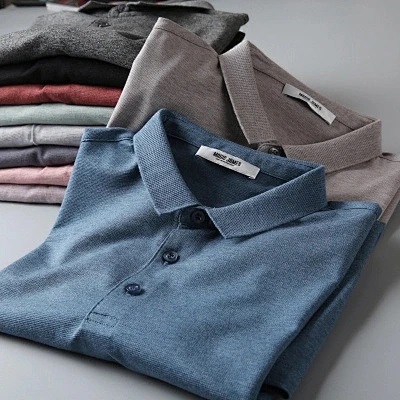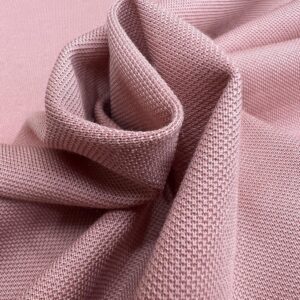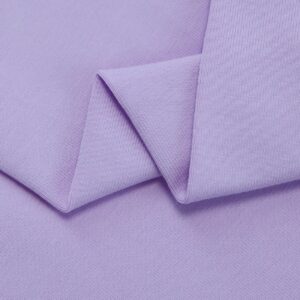Pique vs Jersey: Which is Better for Polo Shirts?

Have you ever noticed that polo shirts feel distinct from traditional T-shirts or button-up shirts? This difference stems from their unique fabrics. Most polos are made from pique and jersey fabrics. You might not have heard these fabrics before, but after reading this article, you’ll know exactly how they differ, their advantages, and which one is best for you. Firstly, let’s take a look at the origins of the Polo shirts…
A Quick History of Polo Shirts
The story of the Polo shirts can be traced back to 1920s France. Tennis player René Lacoste grew frustrated with traditional long-sleeved shirts and trousers, which were uncomfortable and restrictive during matches. So, he designed a short-sleeve collared shirt made from cotton piqué with a few buttons on the chest. The collar could stand up for sun protection or fold down for a sharp look. This became known as Tennis Shirt.
By the 1930s, polo players in the UK caught on. They swapped their heavy, traditional gear for this lightweight garment, and that’s how the “Polo Shirt” got its name, straight from the sport of polo.
In 1933, Lacoste teamed up with his business partner to launch the Lacoste brand, turning his tennis shirt into a commercial hit and adding the iconic green crocodile logo (a nod to his nickname).
Fast forward to 1972, Ralph Lauren brought polo shirts from sports fields to everyday city life, turning them into a timeless symbol of casual elegance. Today, brands like Lacoste, Ralph Lauren, Fred Perry, and Tommy Hilfiger all put their own spin on the polo, blending sporty vibes with laid-back sophistication.
How Are Polo Shirt Fabrics Made?
Polo shirts are typically crafted from knitted fabrics, most commonly pique or jersey. However, to fully understand the differences between these two materials, it’s helpful to first explore the distinction between knitting and weaving.
Knitting: This process involves interlocking loops of yarn to create a flexible and stretchy fabric. Knitted materials, such as those used in polo shirts, T-shirts, and sweaters, are soft, breathable, and adapt to body movement.
Weaving: In contrast, weaving interweaves two sets of yarns, warp (vertical) and weft (horizontal), at right angles to create a tighter, more structured fabric. Woven materials, commonly found in dress shirts, jeans, or suits, are durable and crisp but less elastic and breathable than knits.
Polos are almost always made of knitted fabrics. The two most common types are:
Pique Fabric: A textured knit with a distinctive honeycomb or grid pattern, offering breathability and a structured appearance. It comes in single pique (lightweight, textured on one side) or double pique (thicker, textured on both sides).
Key Features of Pique:
1. Breathability and Moisture-Wicking: The textured weave promotes airflow and quick sweat evaporation.
2. Refined Appearance: Its structured look adds a sophisticated edge, ideal for semi-formal settings.
3. Durability: Pique maintains its shape and resists wear over time.

Jersey Fabric: Most polo shirts are single jersey with smooth loops on the front and subtle horizontal lines on the back. Jersey fabric is soft, stretchy, and comfortable against the skin, offering a more relaxed drape compared to pique.
Key features of Jersey:
1. Comfort: Its smooth texture and stretch make it ideal for unrestricted movement.
2. Appearance: Sleek and minimalist, jersey aligns with modern, casual styles.
3. Care Considerations: Its looser structure may stretch or pill over time, so gentle washing and air-drying are recommended.

Common Fabric Types for Polo Shirts
1. Features a textured front and smooth back.
2. Advantages: Lightweight, breathable, excellent for sweat-wicking.
3. Drawbacks: Less structured, may lack a crisp look.
4. Best for: Summer, sports, casual settings.
1. Textured on both sides for a sturdier feel.
2. Advantages: Excellent shape retention, premium aesthetic.
3. Drawbacks: Less breathable, higher cost.
4. Best for: Business casual, uniforms, upscale occasions.
1. Smooth, single-knit fabric with slight texture on the back.
2. Advantages: Soft, stretchy, lightweight.
3. Drawbacks: Prone to stretching or pilling.
4. Best for: Everyday wear, lounging, warm weather.
Pima Cotton:
1. Premium long-staple cotton used in both pique and jersey.
2. Advantages: Silky texture, durable, subtle sheen.
3. Drawbacks: Higher price, requires careful maintenance.
4. Best for: Luxury polos, business settings.
Pique vs Jersey: Which one is better?
Deciding between pique or jersey fabric for your polo shirt depends on your preferences and lifestyle. In my opinion, if you’re shopping for activewear or casual use, jersey is a great choice. But if you’re going for a more formal, structured look, like a team uniform or business attire, pique fabric is better for you.
How can I Spot the Difference
Appearance: Pique has a visible honeycomb or grid texture, while jersey is smooth and sleek.
Texture: Pique feels slightly textured and firm, jersey is soft and elastic.
Elasticity: Jersey offers more stretch, pique is more stable.
Structure: Pique resembles a business shirt’s crispness, jersey feels like a premium T-shirt.
Care and Maintenance Tips
Pique: Wash in cold water, air-dry, and iron on low to preserve the textured weave.
Jersey: Wash inside out on a gentle cycle, avoid high-heat drying to prevent stretching.
Pima Cotton: Use mild detergent, wash gently, and lay flat to dry to maintain its quality.
Frequently Asked Questions
Q1: Is pique fabric warmer than jersey fabric?
A1: Not necessarily. Pique’s textured weave enhances breathability, while jersey’s denser structure may retain slightly more heat.
Q2: Which fabric is better for sports?
A2: Pique excels in sports like tennis or golf due to its breathability and sweat-wicking properties. Jersey suits lighter activities or casual wear.
Q3: Will a jersey polo shirt look too much like a T-shirt?
A3: A well-designed jersey polo, with a structured collar and button placket, maintains a distinct, polished look compared to a T-shirt.
Q4: Is Pima cotton worth the higher price for polo shirts?
A4: Yes, if you value superior softness, durability, and a subtle sheen. Pima cotton, used in both pique and jersey polos, offers a premium feel and long-lasting quality, making it ideal for business casual or special occasions.
Q5: How do I choose between pique and jersey?
A5: Opt for pique if you need a structured, durable polo for semi-formal or active settings, like work or sports. Choose jersey for everyday comfort and a relaxed, budget-friendly option.
Conclusion
Whether you choose pique or jersey depends on your lifestyle and preferences. Both fabrics have their own advantages.
If you’re looking for high-quality fabrics for your polo shirt project, Factotex is happy to help. Our team will provide you with full support from fabric selection to mass production, ensuring consistent quality and on-time delivery. Need any professional help? We are here for you.
Working With Facto Textile
We promise you:
- A wide variety of high- quality fabrics
- Full range of customized services
- Professional production technology
- Sincere Cooperation
Contact Us To Start Your Fabric Project
Please send us your message, we will reply within 20 hours.
